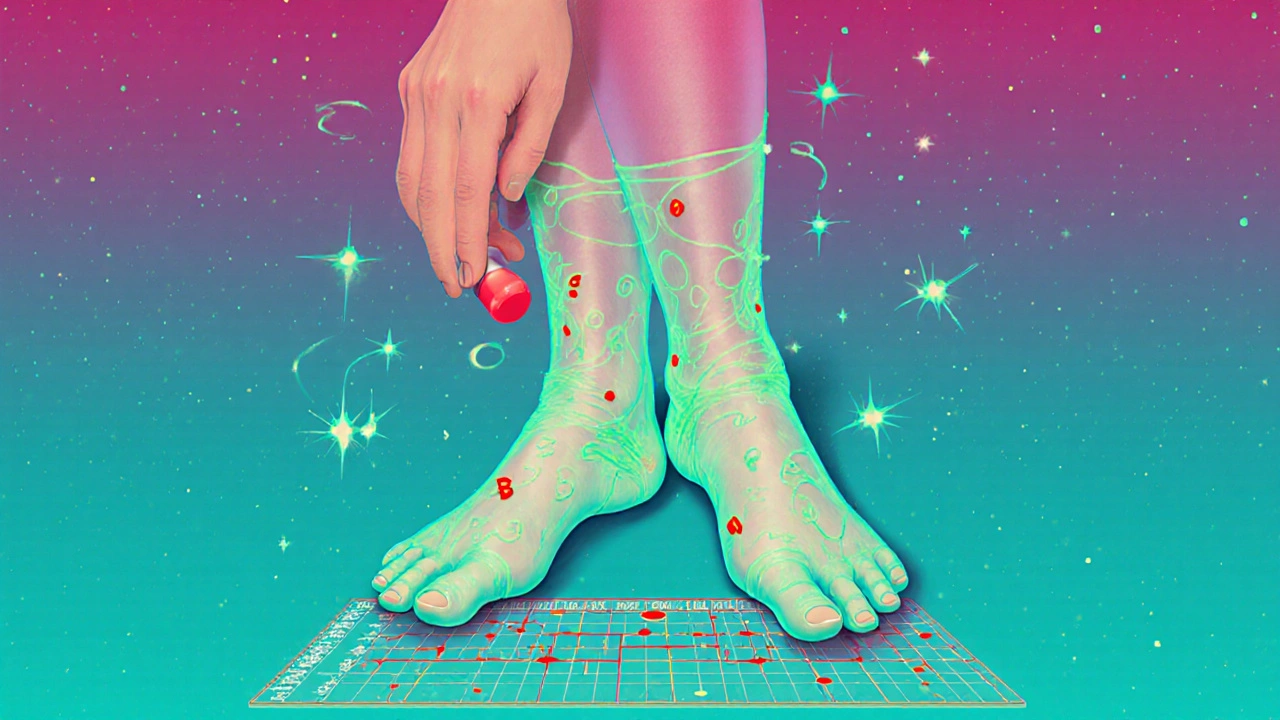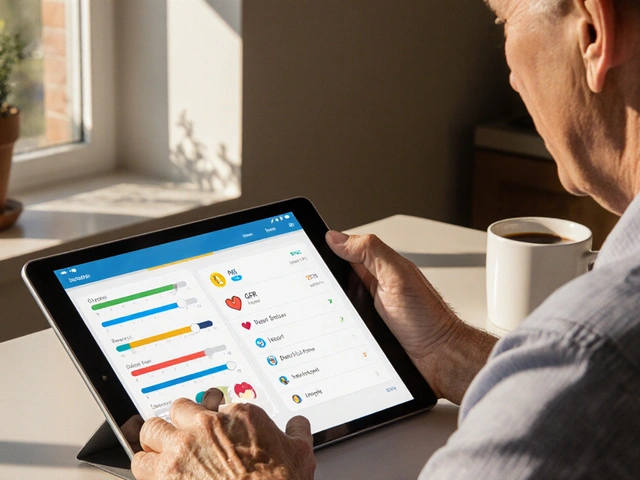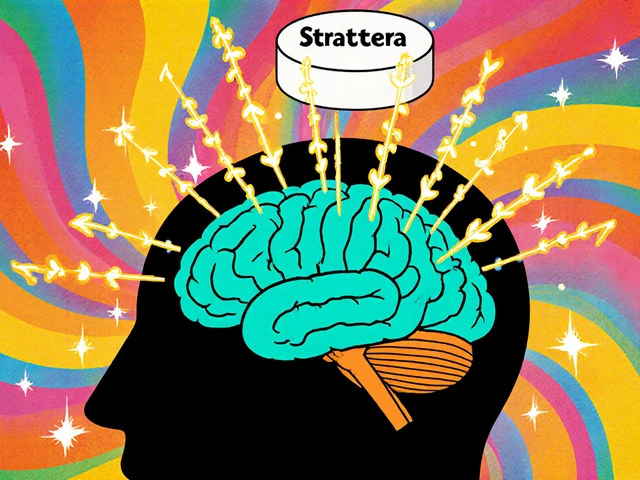When you start taking a statin to lower your cholesterol, you expect better heart health-not aching legs, cramping calves, or tingling feet. But for many people, these symptoms show up. And that’s where things get confusing. Is it your muscles breaking down? Or are your nerves acting up? Statin myopathy and peripheral neuropathy can feel almost the same: both cause discomfort, both make you wonder if the pill is doing more harm than good. But they’re not the same. And mixing them up can change everything-your treatment, your future, even your survival.
What Statin Myopathy Really Feels Like
Statin myopathy isn’t just soreness. It’s your body telling you your muscles aren’t getting the energy they need.If you’re on a statin and notice your thighs feel heavy when climbing stairs, or you need to push off with your hands to stand up from a chair, that’s not aging. That’s myopathy. It’s usually bilateral-both sides-and affects the muscles closest to your trunk: hips, thighs, shoulders. Pain is often described as a dull ache, not sharp or burning. You might not even realize you’re weaker until you trip more often or your balance feels off. The key marker? Creatine kinase (CK). In true statin myopathy, CK levels rise-sometimes four times above normal. But here’s the twist: most people with statin-related muscle symptoms have normal or only slightly elevated CK. That doesn’t mean it’s not real. Studies show that up to 29% of statin users report muscle pain, but only 1 in 1,000 to 1 in 10,000 develop severe myopathy with dangerous CK spikes. Why does this happen? Statins block HMG-CoA reductase, an enzyme your liver uses to make cholesterol. But your muscles use the same enzyme to make coenzyme Q10-a vital fuel for energy production. Within 30 days of starting a statin, muscle CoQ10 drops by 40%. Your muscle cells start starving. Add in disrupted calcium control and faulty protein building, and you’ve got a recipe for muscle breakdown. Risk factors? Age over 65, being female, taking fibrate drugs like fenofibrate, or having the HLA-DRB1*11:01 gene variant. These aren’t rare. In the UK, over 10 million people are on statins. That means tens of thousands are quietly dealing with muscle fatigue they think is normal.
What Peripheral Neuropathy Looks Like (If It’s Even Real)
Neuropathy doesn’t make your muscles weak. It makes your feet feel like they’re wrapped in cotton or burning under hot water.If your symptoms start in your toes-tingling, numbness, a pins-and-needles feeling that climbs up your legs like a stocking-you’re likely looking at neuropathy. It’s usually symmetrical, follows a “stocking-glove” pattern, and gets worse at night. Unlike myopathy, you won’t struggle to stand up. But you might trip on flat ground because you can’t feel where your feet are. Here’s the big controversy: does statin therapy even cause this? Some studies say yes. Others say no. A 2019 case-control study of 616 patients found statin users had lower odds of developing peripheral neuropathy than non-users. Another review in 2021 found conflicting results across 13 studies. So why do people blame statins? Proposed theories include: cholesterol depletion messing with nerve membranes, reduced vitamin E (since statins lower LDL, which carries vitamin E), or CoQ10 shortage affecting nerve energy. But none of these are proven. Electrodiagnostic tests-nerve conduction studies-can confirm if you have axonal neuropathy. But if your CK is normal and your nerves show damage, the cause might be something else: diabetes, B12 deficiency, alcohol use, or even vitamin D deficiency. In fact, the NIH says peripheral neuropathy from statins is still “probable,” not confirmed. That’s critical. If you assume it’s the statin and quit, you might miss the real culprit.
How to Tell the Difference: A Simple Checklist
You don’t need a lab to start ruling things out. Here’s what to look for:- Location: Myopathy = hips, thighs, shoulders. Neuropathy = feet, hands, toes.
- Sensation: Myopathy = aching, heaviness, weakness. Neuropathy = tingling, burning, numbness, loss of feeling.
- Strength: Myopathy = you can’t lift your legs or stand without help. Neuropathy = you can stand fine, but you feel like you’re walking on foam.
- CK levels: Myopathy = often elevated (≥4x ULN). Neuropathy = always normal.
- Response to stopping: Myopathy = improves in weeks after stopping. Neuropathy = may not improve, or may get worse.

What Happens When You Stop the Statin?
Stopping statins sounds like the obvious fix. But here’s the catch: if you have heart disease or high cholesterol, stopping could cost you your life. The Cholesterol Treatment Trialists’ meta-analysis shows a 25% drop in heart attacks and strokes for every 1.0 mmol/L reduction in LDL cholesterol. If it’s myopathy: stop the statin. Symptoms usually fade in 2-3 months. Then try a different one. Hydrophilic statins like pravastatin or rosuvastatin are less likely to cause muscle issues. About 60% of people who had myopathy on one statin can tolerate another. Add ezetimibe or a PCSK9 inhibitor to keep LDL low without the muscle risk. If it’s neuropathy: don’t stop blindly. Rule out diabetes first. Check your B12. Test your vitamin D. Alcohol use? Thyroid problems? These are far more common causes. If nothing else explains it, and your nerve tests confirm damage, then consider switching or stopping-but only after discussing risks with your doctor.What Doctors Often Miss
Most GPs don’t test muscle strength. They ask, “Do you have pain?” and if you say yes, they assume it’s the statin. But weakness isn’t always obvious. You might not realize you’re slower walking, or that you’re using the armrests to get up because your quads are failing. That’s not aging. That’s myopathy. And here’s a scary case from Cureus 2023: a man on statins developed sudden leg weakness and loss of reflexes-mimicking Guillain-Barré Syndrome. He was hospitalized, terrified. Turns out, it was statin myopathy. No infection. No autoimmune trigger. Just a statin and a muscle that couldn’t recover. Patients are often restarted on statins without neurologist input. A 2014 NIH paper documented cases where patients had symptoms resolved by a neurologist, only to have their GP prescribe the same statin again-symptoms returned within weeks.What to Do Next: A Practical Plan
1. Write down your symptoms. When did they start? What exactly do you feel? Where? Does it get worse at night? Do you feel weak or just numb? 2. Get a CK test. If it’s elevated, myopathy is likely. If it’s normal, look elsewhere. 3. Request a nerve conduction study. If you have tingling, numbness, or burning in your feet, this test is non-negotiable. 4. Check for other causes. Blood sugar, B12, vitamin D, thyroid, alcohol use. These are more common than statin neuropathy. 5. Don’t quit statins without a plan. If you need to stop, replace them with ezetimibe or a PCSK9 inhibitor. You can still lower your LDL without muscle damage. 6. Try a different statin. If you had myopathy on simvastatin, try pravastatin. If it was atorvastatin, try rosuvastatin. Many people tolerate the switch. 7. Don’t waste money on CoQ10. A 2015 JAMA study of 44 patients showed no benefit over placebo. It’s not a magic fix.Final Thought: Your Heart Still Matters
Statin side effects are real. But they’re not the whole story. The risk of a heart attack or stroke from untreated high cholesterol is far greater than the risk of muscle or nerve trouble. The goal isn’t to avoid statins-it’s to use them safely. If you’re having symptoms, don’t suffer in silence. Don’t assume it’s normal. Get tested. Get answers. And work with your doctor to find a solution that protects both your muscles-and your heart.Can statins cause permanent muscle damage?
In rare cases, yes-especially with rhabdomyolysis, where muscle tissue breaks down and releases toxins into the blood. But most statin myopathy is reversible. If you stop the statin and symptoms improve within weeks, your muscles likely recovered fully. Permanent damage only happens if the condition is ignored for months and CK stays extremely high, leading to kidney injury. Early detection is key.
Is tingling in my feet definitely neuropathy from statins?
No. Tingling in the feet is far more likely caused by diabetes, vitamin B12 deficiency, alcohol use, or even spinal nerve compression. Statin-induced neuropathy is still debated in medical literature. Don’t assume the statin is the cause without ruling out these more common triggers first. A nerve conduction study will help clarify.
Should I take CoQ10 supplements to prevent statin muscle cramps?
Studies, including a 2015 JAMA trial with 44 patients, found no significant benefit. CoQ10 levels drop with statins, but supplementing doesn’t reliably reduce cramps or weakness. It’s not harmful, but don’t expect it to fix the problem. Focus on identifying the real cause instead.
Can I ever go back on statins after stopping for muscle pain?
Yes-about 60% of people who had muscle pain on one statin can tolerate a different one. Hydrophilic statins like pravastatin or rosuvastatin are better tolerated. Start at the lowest dose. Monitor symptoms closely. If pain returns, it’s likely the same issue. Don’t push through it.
What are the alternatives to statins if I can’t tolerate them?
Ezetimibe and PCSK9 inhibitors (like evolocumab or alirocumab) are proven alternatives. They lower LDL cholesterol without affecting muscles. The American College of Cardiology recommends them for statin-intolerant patients. They’re more expensive, but they reduce heart attack risk just like statins-without the side effects.
Next Steps: When to See a Specialist
If your symptoms persist after 3 months off statins, or if you have both muscle weakness and nerve symptoms, see a neurologist. You might have an underlying condition that was masked by statin side effects-or you might have two separate problems. Don’t wait. Early diagnosis saves both your mobility and your heart.Final Checklist: What to Do Today
- Write down your symptoms-exact location, type, timing.
- Call your doctor and ask for a CK blood test.
- If you have tingling or numbness, ask for a nerve conduction study.
- Check your B12, HbA1c, and vitamin D levels.
- Don’t stop your statin without a replacement plan.
- Research non-statin options like ezetimibe or PCSK9 inhibitors.





Yvonne Franklin
November 23, 2025 AT 22:48CK test first. If it's normal and you've got tingling feet, don't blame the statin. Check your B12 and sugar. I've seen too many people quit statins and end up with a heart attack because they assumed it was the pill.